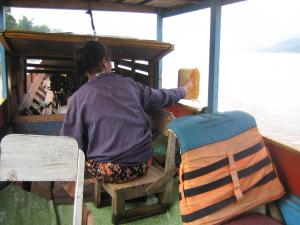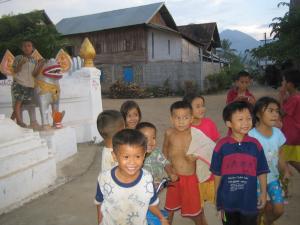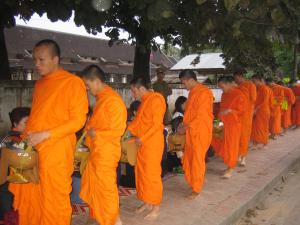Luang Prabang, the jewel of Indochina, is a small village in Laos that UNESCO plans to maintain that way under its World Heritage program. The ancient royal city is surrounded by mountains at the junction of the Mekong and its tributary, the Khan River. The tasty food, great markets, warm climate and exhilarating massages add to the natural splendor. There are no big hotels, no street beggars, just a few cell phones, a couple of cars and almost no abandoned wats (the Thai word for temple, typically a Buddhist one). There are dozens of temples and approximately one monk for every 30 people living there.
Transport troubles in this rural paradise were like umbrellas opened on sunny days: unexpected but everywhere. Driving was unstable; one bounced over the dirt roads, avoiding roosters and dogs running amok. While bicycles were the main mode of travel, there were also motorbikes with carts, a couple of private cars, and, of course, slow boats.
My daughter and I had no intention of going all the way to China, but we did want to see the Pak Ou Caves where, over the course of hundreds of years, people deposited countless numbers of Buddha images. The regular boat tours included visits to a whiskey-making town and another that made pape, neither of which were on our agenda. The guidebooks suggested hiring your own driver to allow freedom of time and sights. We were spirited down the hill to climb aboard an oversized shell with a few worn pillows added for comfort. We hired our captain for the entire day, with plans to venture up and down the Mekong River and a side trip to the Kuang Si Waterfalls.

 Captain's Wife Bailing Water From Vessel
Captain's Wife Bailing Water From Vessel
Erin, my daughter, was the first to notice that our boat was the only one on the river that employed a first mate, the captain’s wife. Even more surprising was the fact that she was very busy bailing water from the back of our vessel. Unfortunately, she had to stop every time the motor sputtered and died. We sensed the potential for problems, but when the motor cut out for the fourth time, we knew we were in trouble! If the current had its way, we would be back at our starting point in less time than we had already spent on the water.
Our driver struggled to get us to shore with a small paddle where once again, he failed to fix the motor. While he labored away, I strained to stay calm, as it was clear I was in no position to save us. Finally, the wife climbed up the bank and started yelling. Just when I thought our plans for the day were cancelled, a larger boat going to the grottos rescued us. The cliffs housing the treasures jutted out over the river hiding two caves, one atop the other, and truly did hold an innumerable number of Buddhist icons both large and small.
The rescue boat captain informed me with a combination of verbal and physical cues that his plans were different than ours, and suggested we take another boat back. Approximately thirty minutes from town, the skipper pulled into shore and indicated that we should get out. I was a little nervous because we had paid up front and did not have a receipt. We were visibly confused. One passenger, recognizing our concern, spoke in Thai to the driver who responded in Lao. She then asked in French if we spoke French. I responded that I spoke a little and then was overwhelmed, understanding only one out of every 10 words. I thought we were to get off the boat and take a tuk-tuk back into town.
Miraculously, our first driver, who had apparently swam across the river, appeared dripping wet in his underwear. He must have explained our problem, as we continued down river where the other passengers were deposited and to the Kuang Si Waterfalls, a magnificent site with pools, stairways and thundering mists. We climbed up the stairs towards the falls until we no longer felt safe and witnessed the power of this beautiful raging perpendicular river. Tourists and locals bathed in the pools, spicy aromas from the various food stalls mingled with the fresh scent of forests, and local arts and crafts hung from string lines. This was a spot where nature merged with commerce in a tranquil manner.

 Children Greeting Author
Children Greeting Author
Sabaidee was the greeting we encountered by the children as we rode our borrowed bicycles the next day over the town’s streets, alleyways and bridges. There did not seem to be any traffic rules other than courtesy. The occasional car passed, (in three days I only saw four different four-wheeled vehicles that were not vans or buses), but the roads were filled with mopeds, bicycles and tuk-tuks. All the two-wheelers had seating room for at least one passenger; some fit a family of four. We delighted when we passed our laundry flying boldly off someone’s front porch. While we stopped to take a picture, three small children tried to catch a ride on the back of our bikes. They climbed aboard waving palm leafs, creating a commotion, clearly not trying to commandeer our bikes, but perhaps earn some money.

 Monks Collecting Food
Monks Collecting Food
One must witness the early morning procession of young orange-robed monks as they weave their way through town collecting food for the day from the villagers. At first glance it reminded me of our Halloween festivities when children go door to door asking for candy. The slow line of carroty hues grew longer with each wat passed. Local women, hunched on their knees out of reverence, put cooked rice and other goodies into the pots carried by each Buddhist monk. Contrasting this, was the young toddler who entertained himself as his mother worked in her shop by taking a whimsical aim with his plastic pistol at the roving holy men.
The last night of our journey was preserved in beauty as we climbed the 329 steps to the summit of Mount Phousi, a hill in the middle of the village. We paid homage to the setting sun whose colors are so majestically copied in the surrounding Buddhist monasteries that filled the panoramic view of Luang Prabang.